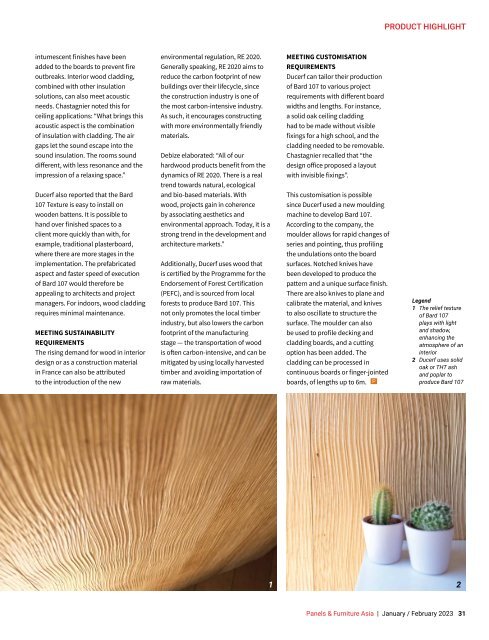Panels & Furniture Asia January/February 2023
Panels & Furniture Asia (PFA) is a leading regional trade magazine dedicated to the woodbased panel, furniture and flooring processing industry. Published bi-monthly since 2000, PFA delivers authentic journalism to cover the latest news, technology, machinery, projects, products and trade events throughout the sector. With a hardcopy and digital readership comprising manufacturers, designers and specifiers, among others, PFA is the platform of choice for connecting brands across the global woodworking landscape.
Panels & Furniture Asia (PFA) is a leading regional trade magazine dedicated to the woodbased panel, furniture and flooring processing industry. Published bi-monthly since 2000, PFA delivers authentic journalism to cover the latest news, technology, machinery, projects, products and trade events throughout the sector. With a hardcopy and digital readership comprising manufacturers, designers and specifiers, among others, PFA is the platform of choice for connecting brands across the global woodworking landscape.
Create successful ePaper yourself
Turn your PDF publications into a flip-book with our unique Google optimized e-Paper software.
PRODUCT HIGHLIGHT<br />
intumescent finishes have been<br />
added to the boards to prevent fire<br />
outbreaks. Interior wood cladding,<br />
combined with other insulation<br />
solutions, can also meet acoustic<br />
needs. Chastagnier noted this for<br />
ceiling applications: “What brings this<br />
acoustic aspect is the combination<br />
of insulation with cladding. The air<br />
gaps let the sound escape into the<br />
sound insulation. The rooms sound<br />
different, with less resonance and the<br />
impression of a relaxing space.”<br />
Ducerf also reported that the Bard<br />
107 Texture is easy to install on<br />
wooden battens. It is possible to<br />
hand over finished spaces to a<br />
client more quickly than with, for<br />
example, traditional plasterboard,<br />
where there are more stages in the<br />
implementation. The prefabricated<br />
aspect and faster speed of execution<br />
of Bard 107 would therefore be<br />
appealing to architects and project<br />
managers. For indoors, wood cladding<br />
requires minimal maintenance.<br />
MEETING SUSTAINABILITY<br />
REQUIREMENTS<br />
The rising demand for wood in interior<br />
design or as a construction material<br />
in France can also be attributed<br />
to the introduction of the new<br />
environmental regulation, RE 2020.<br />
Generally speaking, RE 2020 aims to<br />
reduce the carbon footprint of new<br />
buildings over their lifecycle, since<br />
the construction industry is one of<br />
the most carbon-intensive industry.<br />
As such, it encourages constructing<br />
with more environmentally friendly<br />
materials.<br />
Debize elaborated: “All of our<br />
hardwood products benefit from the<br />
dynamics of RE 2020. There is a real<br />
trend towards natural, ecological<br />
and bio-based materials. With<br />
wood, projects gain in coherence<br />
by associating aesthetics and<br />
environmental approach. Today, it is a<br />
strong trend in the development and<br />
architecture markets.”<br />
Additionally, Ducerf uses wood that<br />
is certified by the Programme for the<br />
Endorsement of Forest Certification<br />
(PEFC), and is sourced from local<br />
forests to produce Bard 107. This<br />
not only promotes the local timber<br />
industry, but also lowers the carbon<br />
footprint of the manufacturing<br />
stage — the transportation of wood<br />
is often carbon-intensive, and can be<br />
mitigated by using locally harvested<br />
timber and avoiding importation of<br />
raw materials.<br />
MEETING CUSTOMISATION<br />
REQUIREMENTS<br />
Ducerf can tailor their production<br />
of Bard 107 to various project<br />
requirements with different board<br />
widths and lengths. For instance,<br />
a solid oak ceiling cladding<br />
had to be made without visible<br />
fixings for a high school, and the<br />
cladding needed to be removable.<br />
Chastagnier recalled that “the<br />
design office proposed a layout<br />
with invisible fixings”.<br />
This customisation is possible<br />
since Ducerf used a new moulding<br />
machine to develop Bard 107.<br />
According to the company, the<br />
moulder allows for rapid changes of<br />
series and pointing, thus profiling<br />
the undulations onto the board<br />
surfaces. Notched knives have<br />
been developed to produce the<br />
pattern and a unique surface finish.<br />
There are also knives to plane and<br />
calibrate the material, and knives<br />
to also oscillate to structure the<br />
surface. The moulder can also<br />
be used to profile decking and<br />
cladding boards, and a cutting<br />
option has been added. The<br />
cladding can be processed in<br />
continuous boards or finger-jointed<br />
boards, of lengths up to 6m. P<br />
Legend<br />
1 The relief texture<br />
of Bard 107<br />
plays with light<br />
and shadow,<br />
enhancing the<br />
atmosphere of an<br />
interior<br />
2 Ducerf uses solid<br />
oak or THT ash<br />
and poplar to<br />
produce Bard 107<br />
1 2<br />
<strong>Panels</strong> & <strong>Furniture</strong> <strong>Asia</strong> | <strong>January</strong> / <strong>February</strong> <strong>2023</strong> 31


















